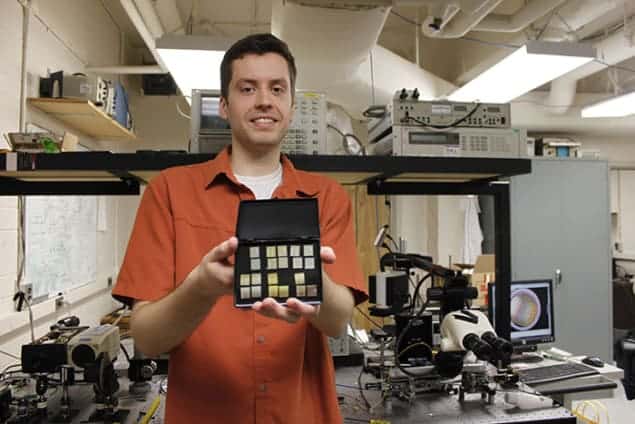
A new kind of silicon photodetector invented by physicists in Canada and the UK should help to ensure that the Internet does not grind to a halt, as people share and download ever-more online data. The device, which could be built using existing chip-fabrication techniques, would ease the pressure on the Web’s data centres by opening up a new frequency range in optical communications.
Ever-greater use of social media, video streaming and other data-heavy applications is causing a rapid rise in Internet use. US technology company Cisco Systems says that worldwide Internet traffic increased more than five-fold between 2008 and 2013, and is set to rise by another factor of three by 2018. This apparently insatiable appetite for online services puts pressure on the hardware that makes up the Internet, and in particular on the huge data centres that route bits and bytes between computers across the globe.
Rising demand
Until now, the companies operating such data centres have tended to use electrical wiring to link the thousands of servers that they employ, but many are now replacing that wiring with fibre-optic cables – these have a number of advantages over the copper variety, including lower losses over long distances, the fact that they do not pick up electromagnetic interference and, crucially, their far greater bandwidth. However, says Andrew Knights of McMaster University in Ontario, even current fibre technology might be swamped by rising user demand within a decade or two.
In the latest work, Knights, together with Jason Ackert and colleagues at McMaster and also the University of Southampton in the UK, have built and tested a photodetector – a device that converts the pulses of light sent down a fibre-optic cable into electrical signals that serve as input to computer processors – that is designed to meet that demand by increasing the range of wavelengths that can be used to send data. Most current cables work at bands centred on 1.3 or 1.5 μm, and transmit data over about 100 different channels within each band – with each channel corresponding to a slightly different wavelength. The new device would, the researchers say, help to open up at least another 100 channels by operating at longer wavelengths, exploiting a band lying in the mid-infrared region at around 2 μm.
Photodetectors operating at mid-infrared wavelengths have already been built from materials other than silicon, notes Knights. But these rival devices, he says, suffer from drawbacks. Germanium–tin detectors, for example, operate too slowly, and produce quite small electrical currents, while detectors based on III–V semiconductors are difficult to integrate into silicon circuitry.
Ion defects
The new device consists of a 3 μm-wide strip of silicon that has a thickness of 220 nm at its centre and just 90 nm at its edges, deposited on a substrate of silicon dioxide. Ordinarily, such a device would serve as a waveguide that is transparent to mid-infrared radiation, but the Anglo-Canadian group inserted ions into the silicon to introduce defects into the lattice structure. These defects result in electronic states within the silicon’s band gap, which allow low-energy mid-infrared photons to excite electron–hole pairs and so generate a measurable photocurrent.
Knights and co-workers have shown that their device generates a reliable electrical response at wavelengths between 1.96 and 2.5 μm, albeit with a lower sensitivity than similar silicon detectors operating at 1.55 μm. They also exposed the device to the output of a 1.96 μm laser diode, showing that at this wavelength it could operate without errors at speeds of greater than 20 gigabits per second – more than any other photodetector at this wavelength.
Easy fabrication
The researchers have also shown that their design could be realized using standard CMOS fabrication, having had their prototype device manufactured at a commercial foundry in Singapore. This is crucial, they say, because it means being able to take advantage of the existing vast infrastructure used to fabricate microchips, so lowering costs significantly. Indeed, waveguides, multiplexers and most of the other components needed for optical-fibre communication in this new frequency band have already been built from silicon by other research groups. “We have shown that our device is fast, that it operates at the right wavelength, and that it is compatible with silicon fabrication,” says Knights. “If you put these things together, that is a major breakthrough.”
Knights points out that there is unlikely to be a mass market for this device until Internet traffic has grown accordingly. But he is confident that the market will materialize. “We can place this in the toolbox and it will be ready when needed,” he says.
The work is published in Nature Photonics.



